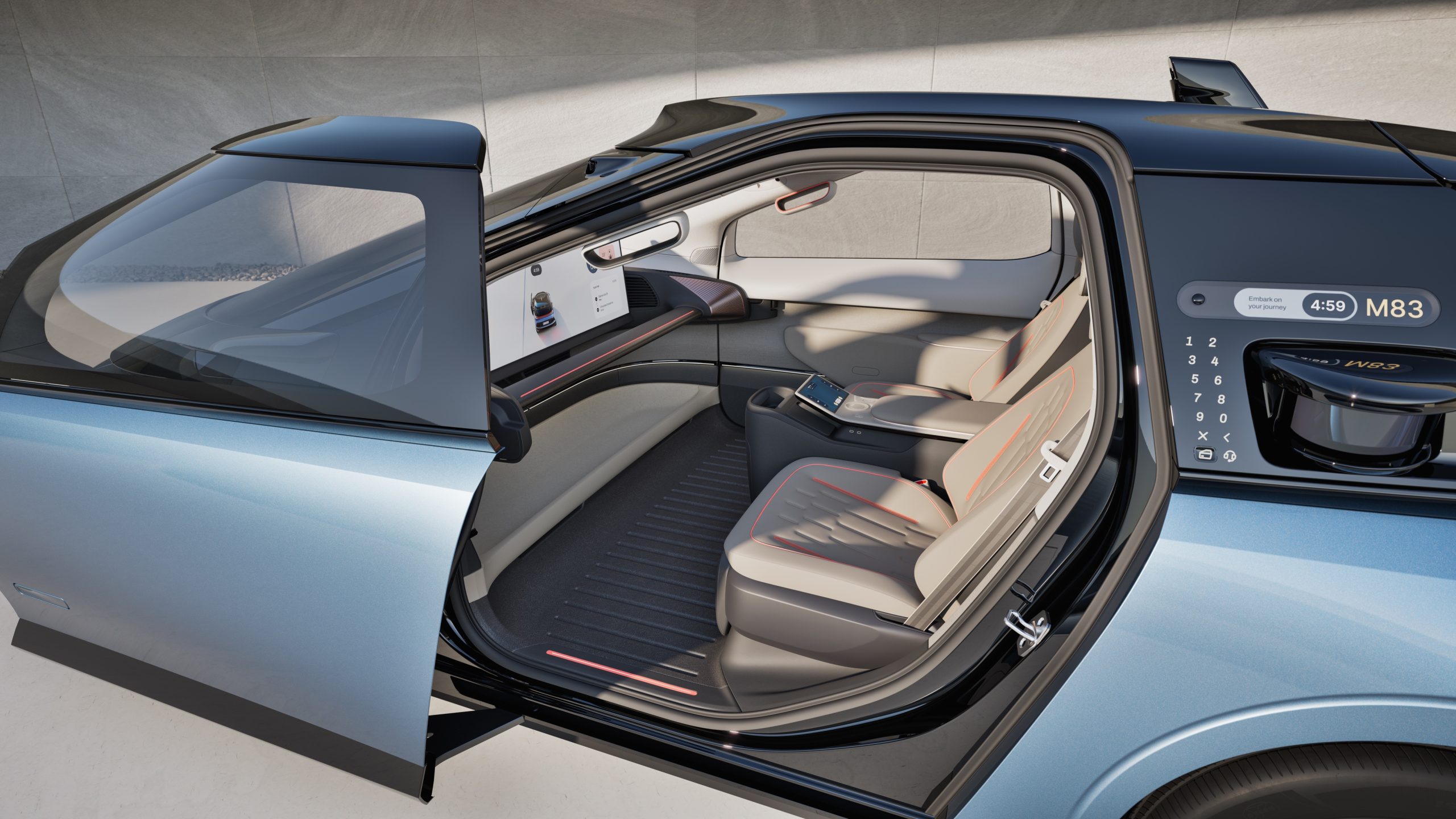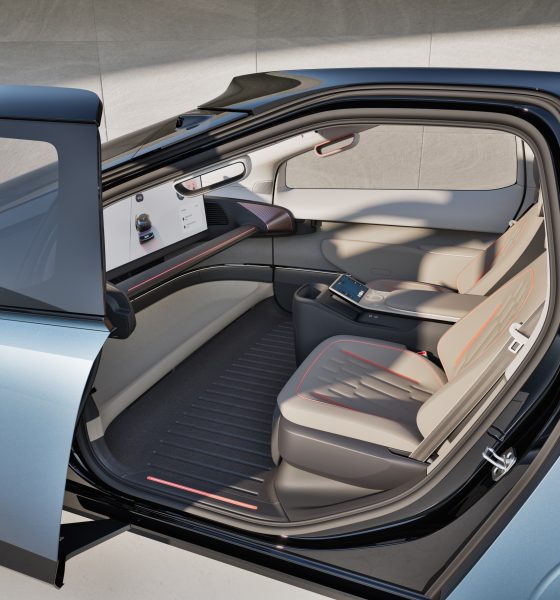Verne is the newest participant in the race to develop a fully autonomous, boundary-free EV robotaxi, and it comes at the hands of Rimac.
A sensation in the realm of EV supercars, Rimac is synonymous with ultra-luxurious electric vehicles that push the boundaries of performance, if you’re willing to pay the price.
Now, the company’s founder, Mate Rimac, and two of his closest colleagues from Rimac Group, both Marko Pejković and Adriano Mudri, have launched Verne, the company’s crack at an autonomous robotaxi that will be launched in Zagreb, Croatia, in 2026.
Mudri has been named Chief Design Officer at Verne, while Pejković takes over as CEO of the new venture. Its goal: built a fully autonomous EV, enable it as a mobility service platform, and build an adequate infrastructure to support it.
Fully Autonomous EV
Verne will launch a vehicle that is built upon a completely new platform that is designed around safety and comfort, two factors that the company feels are most important in the robotaxi experience.
Completely engineered from the ground up, Verne will develop an autonomous EV using Mobileye Drive, an autonomous platform.
Starting from scratch and building what it believes will be fully operational within two years, the platform is free of any compromises and disadvantages that would come from developing a groundbreaking vehicle type with scraps inspired by a vehicle designed for human driving.
Mobility Service Platform (MSP)
Tailored for driver-free pickup, passengers are the first thought in Verne’s initial development. Of course, this is no different than traditional ride-hailing services that exist today, but without a human controlling the wheel, things need to be different.
Before ordering a ride, the Verne app will allow users to completely personalize everything. From temperature to comfort to lighting to scent, those who request a ride from a Verne EV can choose everything.
Infrastructure
Verne will expand past Zagreb in the coming years, and each city where the company operates will be the home of the “Mothership,” where every vehicle is inspected, maintained, cleaned, and charged.
Verne’s first production facility for the new EV will be in Croatia. The cars will be deployed worldwide.
New Leadership
Mudri has huge expectations for Verne, which is named after Jules Verne, an author who is said to be “the man who invented the future”:
“Just as he used the theme of travel as the driving force in his storytelling, we use it as our inspiration in shaping a future filled with imaginative innovation and tangible achievement. His faith in the future and his spirit sparked the curiosity in generations of scientists and explorers. Making things that sometimes seem impossible, possible.”
Mate Rimac said the goal for Verne is to have more than just Point A to Point B transportation:
“The end result would be the best possible mobility experience for everyone. This means that every customer will have a better service than the best mobility service enjoyed by the very rich, through the service that is affordable for all. You will have a safe and reliable driver, a vehicle with more interior space and comfort than the best limousines today, and a service that will be tailored to your needs in every possible way.”
Robotaxi Design
Verne’s robotaxi vehicle will have two seats and an interior concept that “completely redefines” past narratives about interior space. Mudri said that 9 out of 10 rides through ride-hailing services are used by 1 or 2 people:
“Therefore, we can satisfy most of all trips with a two-seater and create unmatched interior space in a compact-sized vehicle. We completely redefined interior space. More space than a Rolls-Royce to relax and spend your time well.
It will also feature things like music and movies with an ultrawide screen and 17 speakers for enhanced audio.
As for the exterior, it will be sleek, with deeply integrated cameras, radars, short and long-distance-lidars, no windshield wipers, and no side-view mirrors:
Čestitamo Mati Rimcu i njegovom timu na izradi prototipa budućeg autonomnog električnog vozila, “Verne”! Ponosni smo na još jednu ?? inovaciju koja će mijenjati svijet. Podupiremo ulaganja koja povezuju digitalnu i zelenu tranziciju i ostvaruju ciljeve 5️⃣.industrijske revolucije. pic.twitter.com/3yK73MESr7
— Andrej Plenković (@AndrejPlenkovic) June 26, 2024
“This makes the aerodynamic performance more efficient and allows for easier cleaning. One typical element of an automobile we kept is the trunk. So you don’t need to worry if you‘re going to the airport with a lot of luggage or just finished a major grocery shopping.”
There’s a long way to go, a lot of competition, and so many variables that come into play with this new project.
I’d love to hear from you! If you have any comments, concerns, or questions, please email me at joey@teslarati.com. You can also reach me on Twitter @KlenderJoey, or if you have news tips, you can email us at tips@teslarati.com.

News
Tesla starts showing how FSD will change lives in Europe
Local officials tested the system on narrow country roads and were impressed by FSD’s smooth, human-like driving, with some calling the service a game-changer for everyday life in areas that are far from urban centers.

Tesla has launched Europe’s first public shuttle service using Full Self-Driving (Supervised) in the rural Eifelkreis Bitburg-Prüm region of Germany, demonstrating how the technology can restore independence and mobility for people who struggle with limited transport options.
Local officials tested the system on narrow country roads and were impressed by FSD’s smooth, human-like driving, with some calling the service a game-changer for everyday life in areas that are far from urban centers.
Officials see real impact on rural residents
Arzfeld Mayor Johannes Kuhl and District Administrator Andreas Kruppert personally tested the Tesla shuttle service. This allowed them to see just how well FSD navigated winding lanes and rural roads confidently. Kruppert said, “Autonomous driving sounds like science fiction to many, but we simply see here that it works totally well in rural regions too.” Kuhl, for his part, also noted that FSD “feels like a very experienced driver.”
The pilot complements the area’s “Citizen Bus” program, which provides on-demand rides for elderly residents who can no longer drive themselves. Tesla Europe shared a video of a demonstration of the service, highlighting how FSD gives people their freedom back, even in places where public transport is not as prevalent.
What the Ministry for Economic Affairs and Transport says
Rhineland-Palatinate’s Minister Daniela Schmitt supported the project, praising the collaboration that made this “first of its kind in Europe” possible. As per the ministry, the rural rollout for the service shows FSD’s potential beyond major cities, and it delivers tangible benefits like grocery runs, doctor visits, and social connections for isolated residents.
“Reliable and flexible mobility is especially vital in rural areas. With the launch of a shuttle service using self-driving vehicles (FSD supervised) by Tesla in the Eifelkreis Bitburg-Prüm, an innovative pilot project is now getting underway that complements local community bus services. It is the first project of its kind in Europe.
“The result is a real gain for rural mobility: greater accessibility, more flexibility and tangible benefits for everyday life. A strong signal for innovation, cooperation and future-oriented mobility beyond urban centers,” the ministry wrote in a LinkedIn post.
News
Tesla China quietly posts Robotaxi-related job listing
Tesla China is currently seeking a Low Voltage Electrical Engineer to work on circuit board design for the company’s autonomous vehicles.

Tesla has posted a new job listing in Shanghai explicitly tied to its Robotaxi program, fueling speculation that the company is preparing to launch its dedicated autonomous ride-hailing service in China.
As noted in the listing, Tesla China is currently seeking a Low Voltage Electrical Engineer to work on circuit board design for the company’s autonomous vehicles.
Robotaxi-specific role
The listing, which was shared on social media platform X by industry watcher @tslaming, suggested that Tesla China is looking to fill the role urgently. The job listing itself specifically mentions that the person hired for the role will be working on the Low Voltage Hardware team, which would design the circuit boards that would serve as the nervous system of the Robotaxi.
Key tasks for the role, as indicated in the job listing, include collaboration with PCB layout, firmware, mechanical, program management, and validation teams, among other responsibilities. The role is based in Shanghai.
China Robotaxi launch
China represents a massive potential market for robotaxis, with its dense urban centers and supportive policies in select cities. Tesla has limited permission to roll out FSD in the country, though despite this, its vehicles have been hailed as among the best in the market when it comes to autonomous features. So far, at least, it appears that China supports Tesla’s FSD and Robotaxi rollout.
This was hinted at in November, when Tesla brought the Cybercab to the 8th China International Import Expo (CIIE) in Shanghai, marking the first time that the autonomous two-seater was brought to the Asia-Pacific region. The vehicle, despite not having a release date in China, received a significant amount of interest among the event’s attendees.
Elon Musk
Elon Musk and Tesla AI Director share insights after empty driver seat Robotaxi rides
The executives’ unoccupied tests hint at the rapid progress of Tesla’s unsupervised Robotaxi efforts.

Tesla CEO Elon Musk and AI Director Ashok Elluswamy celebrated Christmas Eve by sharing personal experiences with Robotaxi vehicles that had no safety monitor or occupant in the driver’s seat. Musk described the system’s “perfect driving” around Austin, while Elluswamy posted video from the back seat, calling it “an amazing experience.”
The executives’ unoccupied tests hint at the rapid progress of Tesla’s unsupervised Robotaxi efforts.
Elon and Ashok’s firsthand Robotaxi insights
Prior to Musk and the Tesla AI Director’s posts, sightings of unmanned Teslas navigating public roads were widely shared on social media. One such vehicle was spotted in Austin, Texas, which Elon Musk acknowleged by stating that “Testing is underway with no occupants in the car.”
Based on his Christmas Eve post, Musk seemed to have tested an unmanned Tesla himself. “A Tesla with no safety monitor in the car and me sitting in the passenger seat took me all around Austin on Sunday with perfect driving,” Musk wrote in his post.
Elluswamy responded with a 2-minute video showing himself in the rear of an unmanned Tesla. The video featured the vehicle’s empty front seats, as well as its smooth handling through real-world traffic. He captioned his video with the words, “It’s an amazing experience!”
Towards Unsupervised operations
During an xAI Hackathon earlier this month, Elon Musk mentioned that Tesla owed be removing Safety Monitors from its Robotaxis in Austin in just three weeks. “Unsupervised is pretty much solved at this point. So there will be Tesla Robotaxis operating in Austin with no one in them. Not even anyone in the passenger seat in about three weeks,” he said. Musk echoed similar estimates at the 2025 Annual Shareholder Meeting and the Q3 2025 earnings call.
Considering the insights that were posted Musk and Elluswamy, it does appear that Tesla is working hard towards operating its Robotaxis with no safety monitors. This is quite impressive considering that the service was launched just earlier this year.










